Serviços Personalizados
Journal
Artigo
Indicadores
-
 Citado por SciELO
Citado por SciELO -
 Acessos
Acessos
Links relacionados
-
 Similares em
SciELO
Similares em
SciELO
Compartilhar
Revista mexicana de ciencias pecuarias
versão On-line ISSN 2448-6698versão impressa ISSN 2007-1124
Rev. mex. de cienc. pecuarias vol.7 no.4 Mérida Out./Dez. 2016
Articles
Seasonal aerial biomass accumulation of native lucerne (Medicago sativa L.)
a Instituto Politécnico Nacional, CIIDIR, Unidad Oaxaca. Hornos 1003, Sta. Cruz Xoxocotlán, Oaxaca, México. Tel. 01 951 51 706 10 Ext. 82754.
b Instituto de Investigación de Zonas Desérticas. Universidad Autónoma de San Luís Potosí. México.
c Instituto Politécnico Nacional, CIBA Tlaxcala. México.
To know the dynamics herbage yield at different times of the year, is a useful methodology for improving pasture management and optimize the performance and quality plant. The aim of the study was to determine the herbage accumulation curves, average growth rate, forage height, leaf:stem ratio, and botanical composition in a lucerne pastureland of 3 yr of established. The experimental design was a randomized complete block design with four replicates. The highest dry matter yield was recorded (P<0.01) at 49 regrowth days in spring, summer and autumn (2,794, 2,680 and 2,116 kg DM ha-1, respectively), and 42 d in winter (3,416 Kg DM ha-1). The highest growth rates (61 kg DM ha-1 d-1) and the lower leaf:stem ratio was recorded in the winter. The increased presence of other grasses and weeds was in spring and summer. It concludes to make defoliations every 35 to 40 d in winter and autumn, whereas in spring and summer every 30 to 35 d, not every 40 d regardless of the season, as it is commonly done in the region.
Key words: Growth dynamics; Yield; Native lucerne
El conocimiento de las dinámicas de acumulación de biomasa de una especie forrajera en las diferentes épocas del año, es una metodología útil para una mejor planeación y aprovechamiento del cultivo para obtener los mayores rendimientos y material vegetal de buena calidad nutritiva. El objetivo del presente estudio fue determinar curvas de acumulación de forraje, tasa de crecimiento, altura de forraje, relación hoja:tallo y composición botánica, en una pradera de alfalfa de tres años de establecida. Se utilizó un diseño experimental de bloques completos al azar con siete tratamientos y cuatro repeticiones. El mayor rendimiento de materia seca se registró (P<0.01) a los 49 días de rebrote en primavera, verano y otoño (2,794, 2,680 y 2,116 Kg MS ha-1, respectivamente), y a los 42 días en invierno (3,416 kg MS ha-1). Las mayores tasas de crecimiento (61 kg MS ha-1d-1) y la menor relación hoja:tallo se registraron en el invierno. La mayor presencia de otros pastos y malezas fue en primavera y verano. Se concluye realizar cortes cada 35 a 40 días en invierno y otoño, mientras que en primavera y verano cada 30 a 35 días, y no cada 40 días independientemente de la estación del año, como se hace comúnmente en la región.
Palabras clave: Dinámicas de crecimiento; Rendimiento de forraje; Alfalfa criolla
Lucerne (Medicago sativa L.) is the legume most used for livestock feeding around the world, its importance lies in its yield and nutritional value1. Its phenology and regrowth rate allows repeated crops2. In the State of Oaxaca, the use is either green or marketed in bulk3.
The forage regrowth is considered as the time it takes the plant to recover the removed biomass after a defoliation, hence the importance of knowing the plant phenology to accumulate their biomass between crops4. With the advance of the maturity, physical and chemical changes of the forage cause a decreased digestibility and increased yield, reducing the leaf:stem ratio, which is linked with quality, since the leaves and stems contain different concentrations of protein and fiber5,6; likewise, the regrowth depends on the morphogenesis of the plant for the production of leaves7.
A scheme of management based on a calendar resting days or by the stage of development of the crop, is a good choice for handling, reaching the widespread recommendation of harvest when there is a 10 % flowering or the presence of the leave flag, in legumes and grasses respectively; however, a recommendation cannot be universally applicable8,9. Therefore, it is necessary to know the dynamics of biomass accumulation after defoliation, which varies by environmental factors. In this way, knowledge of seasonal changes in yield, allows to determine the best harvest frequency, to get more high quality forage production by area10,11.
In this regard in the State of Mexico, a study12 reported that lucerne presented a higher forage yield on May. Also13, in Oaxaca, assessing five lucerne varieties found that the greater dry matter (DM) yield was on July and August, with an average of 2.82 t DM ha- 1, and presented the following descending order: summer 31 % > spring 27 % > fall 22 % > winter 20 %. Another investigation14 in Oaxaca reported that 14 varieties of lucerne grown in greenhouse and with fertigation, does not register variations in DM yield; however, the highest yield and height were recorded on April and May, so the temperature is closely related to the forage performance15.
In several research studies has been shown the importance of regrowth and the effect of the harvest frequency in the persistence, and the environmental effect on yield, which allows for more efficient handling of animal-vegetal production per hectare16. In a study conducted in Oaxaca10 recorded that in spring, lucerne variety Valencia, reached its maximum performance at the 6th wk (4.7 t DM ha-1), while the variety Oaxaca (creole lucerne) recorded it at 7th wk (4.1 t DM ha-1), concluding that the optimum time of cutting varied with the season of the year.
The quality, yield, persistence and longevity of the pasture depends on seasonal frequency of defoliation management, so defining the cuts calendar based on the re-emergence of the crop in each season is of paramount importance13. However, in the central valleys of Oaxaca, lucerne is harvested every 40 d regardless of the season of the year, causing changes in its morphological and biochemistry composition. Therefore, the objective of the present study was to evaluate the dynamics of seasonal growth in a pastureland of lucerne Var. Oaxaca or Creole, to determine the optimum time to harvest by season, to get the highest yield and forage quality.
The study was conducted in a meadow of lucerne Var. Oaxaca creole (Medicago sativa L.) of 3 yr of established during a year of assessment (February 2011 - January 2013), located in the community of the Villa de Zaachila, Oaxaca, at 16° 56' 38.58” N and 96° 44' 12.61” W, at an altitude of 1,509 m. The climate is temperate subhumid C(w), with rains in summer, with an average annual temperature of 17.5 oC, and average rainfall of 730 mm. The type of soil is shallow, dark grey, with horizon A Malic acid, horizon B argillic, clayey texture, strong adhesiveness and plasticity, slightly pH alkaline, of medium fertility, classified as a Foazen livic17.
For standardization, lucerne was cut at a height of 5 cm at the beginning of the experiment. The blocks were delimited based on the ground slope and established 28 experimental units of 5 x 2 m, using a randomized complete block design with seven treatments (week of cutting) and four replications. The pasture was not fertilized and in the dry season (October to May) irrigation was provided every 2 wk to field capacity.
Forage yield was measured with a steel frame of 0.25 m2 per replicate15; in the randomly selected sample place, all the fodder contained within this place was cut to a height of 5 cm; the harvested plant material was deposited in paper bags previously marked with the number of treatment and the corresponding repetition, it was washed and weighed fresh, then dried in a microwave oven until constant weight to obtain the dry matter value18.
The forage height was recorded before each cut with a graduated ruler 1 m length and a precision of 0.5 cm. There were ten measurements within each treatment, plants chosen at random, with the settled rule completely vertical from the base of the plant to the youngest higher leaf19,20.
Forage harvested in each experimental unit was mixed to homogenize the sample and subsequently took a sub-sample of approximately 20 % of the forage and plants were classified by species, dead material, other grasses and weeds; it was separated into its morphological components (stems, leaves, inflorescence and dead material); each component weighted in fresh and recorded their weight in dry basis1.
The growth rate (GR) was calculated with data of dry matter yield through the following formula: GR= HF/t. Where HF= harvested forage (kg DM ha-1), and t= days between a cut and the next.
The leaf:stem ratio was obtained by dividing the morphological component leaf yield between the component stem yield.
Monthly data average temperature (maximum, average and minimum) weather and precipitation during the study period were obtained from the meteorological station of the airport Benito Juárez from the city of Oaxaca, located 13 km from the study area.
The grouped values were graphed using the statistical software SigmaPlot vol.1221 and analyzed with the PROC MIXED procedure of SAS22. When the assumption of normality of variables was not fulfilled, they were transformed according to the suggestions of SAS. The Akaike criterion was used to select the variance and covariance matrix23, with what the effects of the sources of variation were determined: days of regrowth (7, 14, 21, 28, 35, 42, 49), time of the year (spring, summer, autumn and winter), that were considered as fixed effects, and the effect of blocks considered as random24. Treatments means were estimated using LSMEANS and comparison among them was carried out by the probability of the difference (PDIFF), based on the “t” test of “Student” to a level of significance of 5 %.
For the linear regression between the height of the pasture and forage yield, the height was performed just prior to the sampling of the forage. The equations of linear regression, and 95 % confidence intervals and prediction of performance for time of the year, were obtained by the wizard regression module of the SigmaPlot V.12 software using a polynomial linear model21.
The greatest dry matter yield (P<0.01) was recorded in winter at 14 d compared with yields in spring, summer and fall, with lower yields in the fall (Figure 1A). Table 1 shows that all seasons showed a gradual increase in forage accumulation, reaching greater yields at 49 d in spring, summer and autumn with 2,794, 2,680 and 2,116 kg DM ha-1, respectively, while in winter it was at 42 d (3,416 kg). Taking into account the maximum performance obtained in each of the seasons of the year, the winter exceeded on 22, 27 and 61 %, to spring, summer and autumn, respectively. In particular in spring there were no differences (P>0.05) in the yield among d 35, 42 and 49 of regrowth.
Table 1 Forage yield, growth rate, forage height and leaf: stem ratio in native lucerne grasslands subjected to growth cycles of 7 wk
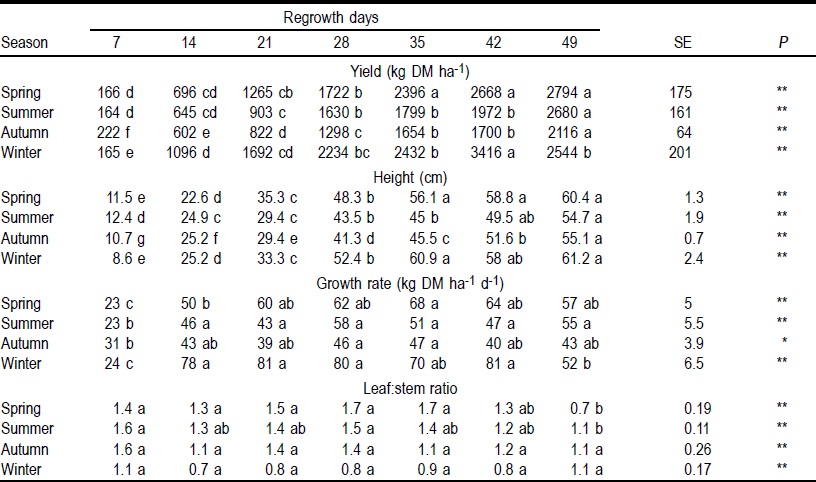
abcd Means with the same letters in each row are not different. SE = standard error.
* (P<0.05); ** (P<0.01).
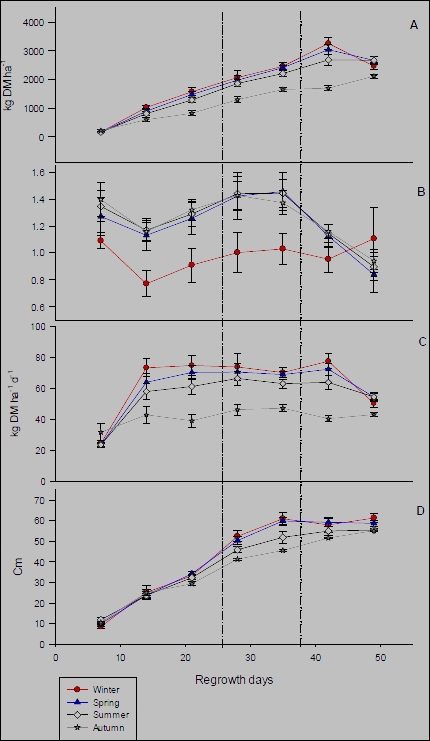
Figure 1 Dry matter yield (A), Leaf:stem ratio (B), Growth rate (C), Forage height (D). In seven weeks growth cycles
These results differ with those reported elsewhere1,25, which concluded that the best seasonal lucerne yield in Montecillo, State of Mexico, was observed in summer; and agrees partially to reports with the same lucerne variety10, which mention that the higher dry matter accumulation was at 49 d in spring, but do not agree to what was reported in summer, autumn and winter, where higher biomass accumulation occurred on d 28, 35 and 42, respectively.
Differences in results may be due to temperature in the winter, as during those months the average temperature fluctuated between 19 and 21 °C while in other studies the presence of frost affected the net lucerne accumulation1,12,16. According to what was reported in the literature26, the optimum temperature for lucerne growth is of 15 to 25 °C during the day and 10 to 20 °C at night. Yield decrement at wk 7 all times of the year may be because the plant enters its reproductive phase, and with maturity, senescence is increased in the total population of plants. But this yield loss can be compensated by other components of the pastureland as the relationship size:density27.
With respect to the plant height (Table 1) during spring and winter there were no differences after 35 d of regrowth (56 to 60 cm and 58 to 61 cm, respectively); in the summer on d 42 and 49 (49.5 to 54.7 cm); and only in autumn was recorded a higher height (P<0.01) until wk 7 (55 cm). Figure 1D, shows that with the exception of winter and spring, after 28 d of regrowth summer and autumn recorded lower heights (P<0.05). Forage height is a variable that is highly correlated with dry matter yield20, if the correlation coefficients are high (> 0.80), this variable can be considered to determine the yield and define the optimum harvesting time. In this experiment in the four seasons of the year the r2 were higher than 0.8 (Figure 2), which indicates that the parameters obtained are acceptable and similar to other researchs19,20. Other authors14 reported that with lucerne in greenhouse and under fertigation conditions, the highest yields coincided with higher values of forage height. Other stuudies28 mention that the heights of the forage varies only in the first year of establishment of the crop, but from the second year onwards, the heights are not significant (P>0.05), so regardless of the variety, the lucerne presents similar heights; however the temperature influences yield and height by time of year.
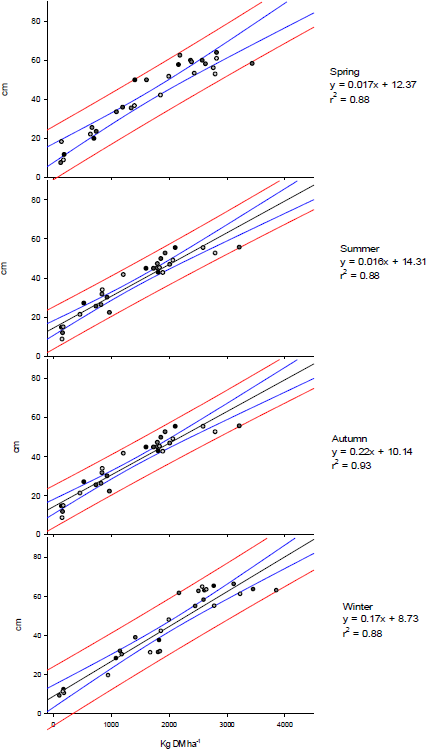
Slope of the line (black line), confidence interval (blue line), prediction of the data (red line).
Figure 2 Linear regressions of the yield vs height, confidence interval at 95, and prediction of the data, in the four seasons of the year
The growth rate is an approximation of plant biomass accumulation in time after defoliation. The age at which lucerne reached the highest GR varied depending on the time of year (Table 1), and the higher GR values recorded were in the winter, at 21, 28 and 42 d of regrowth (81 kg DM ha-1 d-1)(P<0.05); in the spring there was not a difference from 21 to 57 d of growth; however, the greatest record was at 5 wk (68 kg); in summer the highest value was at d 28 (58 kg DM ha-1 d-1); and in the fall to 28 and 35 d (47 kg). With the exception of the fall (P<0.05) there were not reported differences among days of cutting in the GR, just in winter at wk 1 presented the lower GR, but subsequently in wk 2 to 6, it was superior to the other seasons of the year (Figure 1C). These values are similar to those observed in another study10, with the same lucerne variety from a year of established; the higher GR was in spring between d 28 and 35, while in winter only matched by the 6th wk of regrowth. These results differ to results from other studies25,29, where report lower GR values in winter, unlike this work; however, in both studies25,29 the presence of frost led to a lower growth rate, unlike the present study where there were no frost in winter (Figure 3).
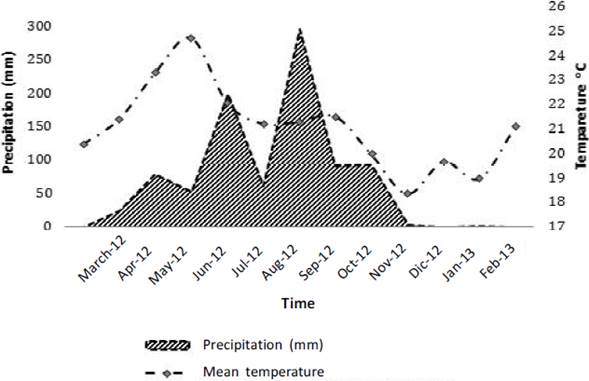
Figure 3 Climate data during the experimental period. Source: Meteorological station of the Benito Juárez airport, of the Oaxaca city
The leaf:stem ratio is the variable most correlated with the nutritious forage quality, and in this experiment that was so, in that except for the winter (P<0.05), there were no differences at other times (Figure 1B). Differences between regrowth days were only in spring and summer (P<0.01), being the d 28 and 35 which recorded the greatest value (1.7 and 1.5, respectively). In autumn the best value was at d 28 and in winter to d 35 (Table 1). Rivas et al13 mention that the lowest ratio occurs in lucerne varieties that produce the greatest dry matter yield, and corroborates the importance of the variables stem (height and weight) in relation to the leaves, for the accumulation of total dry matter and the quality or nutrition in the plant; i.e. that the higher height the lower leaf proportion, and this is related to the growth phase of the forage. Other works6 mentioned that the amount of protein in the leaves and stem, is affected by age of the crop, but it has no influence on the content of dry matter and crude fiber; therefore, the cut must be defined by a combination of variables of the species assessed. Other authors9, mention that the emergence of primary leaves is increased when lucerne is in their regrowth stage, during reproduction or destined to the production of seed, and this has repercussions on the interception of light, biomass root accumulation, and therefore in the total biomass yield and nutritive quality of the forage.
The obtained results differ to those reported with the same lucerne variety and in the same area10, explaining that the lowest leaf:stem ratio presented the following descending order: autumn > summer > winter > spring, and that regardless of the season of the year, the relationship tended to decrease as the week of regrowth increased. In the same way it has been reported25 that greater leaf:stem ratio was presented in autumn and winter. A progressive decrease in the ratio was observed in another study30 in which as regrowth age of lucerne increased, registered greater forage accumulation at the 5th wk in summer, autumn and spring while in winter it was at the 6th wk. These differences could be explained because in the present study the temperature conditions in winter led to a greater dry matter accumulation and the development of more tall stems (Figure 1D), which increased its yield contribution; this, coupled with a faster replacement tissue as it could be observed by greater growth rates in this period (Figure 1C), led to the presence of senescent material, and the loss of leaves by this process caused the leaf:stem ratio (Figure 1B) be lower than in the other seasons.
Regarding the botanical composition (Figure 4), components recorded a variation in their contribution according to the seasons of the year; the biggest contribution of lucerne was recorded in winter and autumn, and the increased presence of other grasses and weeds was in spring and summer. In the winter and summer seasons the biggest contribution of lucerne was at 28 d of growth, in spring at 21 and 35 d, and in the fall until the d 49 (Figure 3). These results agree with those reported elsewhere25, which in spring and summer were increased presence of weeds; it has also been reported a greater percentage of weeds in autumn and lesser in summer seasons, while in spring there was an increase in the percentage of weeds and a reduction in lucerne29. This is consistent with the increase in rainfall in both times, which along with the temperature, led to the emergence of other grass species that came into competition with lucerne.
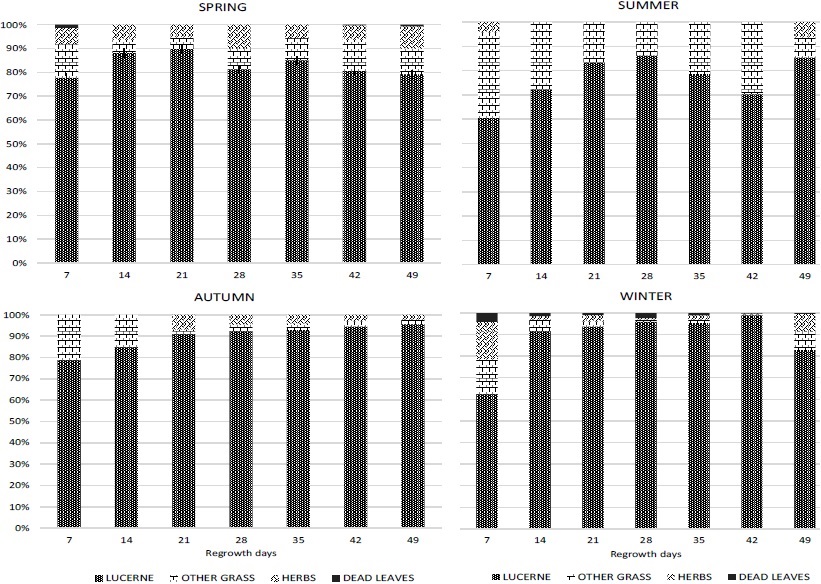
Figure 3 Botanical composition of native lucerne, in cycles of growth of 7 wk, at different times of the year
In conclusion, for the cultivation of lucerne Var. Creole Oaxaca, in the village of Zaachila, the best time for cutting is every 30 to 35 d in winter and spring, and every 35 to 40 d in summer and autumn, to obtain the highest forage yields and better leaf:stem ratio. Cutting should be based on the dynamics of growth, the growth rate, leaf:stem ratio, botanical composition and height variables, in order to obtain the optimum defoliation time for the best content of leaf with respect to stem, best height and lower proportion of dead material, which allows to obtain a better forage quality. The growth dynamics determine the phenological crop performance at different times of the year, which varies depending on the environmental conditions.
Literatura citada
1. Mendoza PSI, Hernández GA, Pérez PJ, Quero CAR, Escalante EAS, Zaragoza RJL, Ramírez RO. Respuesta productiva de la alfalfa a diferentes frecuencias de corte. Rev Mex Cienc Pecu 2010;1(3):287-296. [ Links ]
2. Cangiano CA, Pece MA. Acumulación de biomasa aérea en rebrotes de alfalfa en Balcarce. Rev Arg Prod Anim 2005;(25):39-52. [ Links ]
3. Villegas AY, Hernández GA, Martínez HPA, Pérez PJ, Herrera HJG. López CC. Rendimiento de forraje de variedades de alfalfa en dos calendarios de corte. Rev Fitotec Mex 2006;29(4):369-372. [ Links ]
4. Hernández-Garay A, Matthew C, Hodgson, J. The influence of defoliation height on dry-matter partitioning and CO2 exchange of perennial ryegrass miniature sward. Grass Forage Sci 2000;(54):1-5. [ Links ]
5. Basigalup D. Mejoramiento de la calidad forrajera de la alfalfa. Rev Agromer 2000;(42):16-18. [ Links ]
6. Cupic T, Grljusic S, Popovic S, Stjepanovic M, Tucak M. Protein and fiber contents in alfalfa leaves and stems. In: Delgado I, Lloveras J editors. Quality in lucerne and medics for animal production. Zaragoza, Spain: CIHEAM;2001:215-218. [ Links ]
7. Martiniello P, Texeria da Silva JA. Physiological and bioagronomical aspect involved in growth and yield components of cultivated forage species in Mediterranean environments: A review. Eur J Plant Sci Biot 2011;5(2):64-98. [ Links ]
8. Teixeira EI, Moot DJ, Brown HE. Defoliation frequency and season affected radiation use efficiency and dry matter partitioning to roots of Lucerne (Medicago sativa L.) crops. Euro J Agr 2008;(28):103-111. [ Links ]
9. Teixeira EI, Brown HE, Meenken ED, Moot DJ. Growth and phenological development patterns after between seedling and regrowth lucerne crops (Medicago sativa L.). Euro J Agr 2011;(35)47-55. [ Links ]
10. Villegas AY, Hernández GA, Pérez PJ, López CC, Herrera HJG, Enríquez QJF, Gómez VA. Patrones estacionales de crecimiento de dos variedades de alfalfa (Medicago sativa L.). Téc Pecu Méx 2004;42(2):145-158. [ Links ]
11. Velasco ZME, Hernández GA, González HVA. Cambios en componentes del rendimiento de una pradera de ballico perenne, en respuesta a la frecuencia de corte. Rev Fitotec Mex 2007;30(1):79-87. [ Links ]
12. Dorantes, J. Respuesta productiva de tres variedades de alfalfa (Medicago sativa L.) a dos intensidades de pastoreo [tesis maestría]. Texcoco, Edo. de México: Colegio de Posgraduados; 2000. [ Links ]
13. Rivas JMA, López CC, Hernández GA, Pérez PJ. Efecto de tres regímenes de cosecha en el comportamiento productivo de cinco variedades comerciales de alfalfa (Medicago sativa L.). Téc Pecu Méx 2005;43(1):79-92. [ Links ]
14. Morales AJ, Jiménez VJL, Velasco VVA, Villegas AY, Enríquez VJR, Hernández GA. Evaluación de 14 variedades de alfalfa con fertirriego en la mixteca de Oaxaca. Téc Pecu Méx 2006;44(3):277-288. [ Links ]
15. Castro RR, Hernández GA, Vaquera HH, Hernández GJ, Quero CA, Enríquez QJF, Martínez HPA . Comportamiento productivo de asociaciones de gramíneas con leguminosas en pastoreo. Rev Fitotec Mex 2012;35(1):87-95. [ Links ]
16. Hernández GA, Pérez PJ, Hernández JA. Crecimiento y rendimiento de la alfalfa en respuesta a diferentes regímenes de cosecha. Agrociencia 1992;(2):131-144. [ Links ]
17. INEGI. Mapa geoestadístico municipal, versión 3.1. http://www3.inegi.org.mx/sistemas/mexicocifras/datos-geograficos/20/20565.pdf Consultado 30 Mar, 2015. [ Links ]
18. Crespo RJ, Castaño JA, Capurro JA. Secado del forraje con el horno de microondas: efecto sobre el análisis de calidad. Agric Téc 2007;67(2):210-218. [ Links ]
19. Castro RR, Hernández GA, Aguilar BG, Ramírez RO. 2011. Comparación de métodos para estimar rendimiento de forraje en praderas asociadas. Naturaleza y Desarrollo 2011;9(1):38-46. [ Links ]
20. Castillo EG, Valles MB, Jarillo RJ. Relación entre materia seca presente y altura en gramas nativas del trópico mexicano. Téc Pecu Méx 2009;47(1):79-92. [ Links ]
21. SigmaPlot. User´s Guide (Version 12.0.). Systat software 2015. [ Links ]
22. SAS. User´s Guide: Statistics (Version 9.0 ed.). Cary NC, USA: SAS Inst. Inc. 2002. [ Links ]
23. Wolfinger RD. Covariance structure selection in general mixed models. Communications in statistics simulation and computation. Philadelphia 1993;22(4):1079-1106. [ Links ]
24. Littell RC, Milliken GA; Stroup WW, Wolfinger RD. SAS System for mixed models. Cary: SAS Institute, 1996. [ Links ]
25. Rojas GA. Dinámica de crecimiento y rendimiento de forraje de diez variedades de alfalfa. [tesis maestría]. Texcoco, Edo. de México: Colegio de Posgraduados; 2011. [ Links ]
26. Muslera PE, Ratera CG. Praderas y forrajes, producción y aprovechamiento. 2ª ed. Madrid, España: Ediciones Mundi-Prensa; 1991. [ Links ]
27. Brown HE, Moot DJ, Teixeira EI. The components of lucerne (Medicago sativa) leaf area index respond to temperature and photoperiod in a temperate environment. Euro J Agr 2005;23:348-358. [ Links ]
28. Altinok S, Karakaya A. Forage yield of different alfalfa cultivars under Ankara Conditions. Turk J Agric For 2002;(26):11-16. [ Links ]
29. Cadena VS. Dinámica de crecimiento y rendimiento de alfalfa (Medicago sativa L.) en respuesta a diferentes frecuencias de cosecha [tesis maestría]. Edo. de México: Colegio de Posgraduados; 2009. [ Links ]
30. Zaragoza EJ, Hernández GA, Pérez PJ, Herrera HJG, Osnaya GF, Martínez HPA, et al. Análisis de crecimiento estacional de una pradera asociada alfalfa-pasto ovillo. Téc Pecu Méx 2009;47(2):173-188. [ Links ]
Received: June 01, 2015; Accepted: August 10, 2015











 texto em
texto em 


